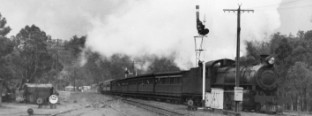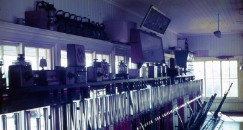Mount Helena
WAGR - Eastern Railway (E. R.) | |
1938 WAGR MAP Mileage = 24 | |
Next Down Station: | Next Up Station: |
Quick Facts |
|
Opened |
Closed |
1904 |
1966 |
Mechanical |
Electrical |
18 Levers |
Signal Panel ? |
Fate: Unknown, but presumed demolished |
|
Mount Helena signal box was located on the W.A.G.R. Eastern Railway and was notable as being the junction for the Smith’s Mill Branch. This was not always the case however. From the opening of the Guildford to Chidlow's Well section on the 11th of March 1884, the Eastern Railway took a steeply graded, and in places sharply curved, route up through the Darling Scarp. This line passed through locations such as Greenmount; Boya; Darlington; Glen Forrest; Nyaania; Mahogany Creek; Zamia; Mundaring and Sawyers Valley. This line became a ‘branch’ when the line through Parkerville opened in 1896. Mount Helena itself was formerly known as Lion Mill and even prior to this, White’s Mill.
Mount Helena shared the same design as the structure at Clackline (the junction for the Toodyay line). The trains worked by the Signalmen here were destined for a large variety of stations and sidings throughout the W. A. G. R. network including the Great Southern Railway and Eastern Goldfields Railway. Whilst Mount Helena was a junction station, it was however unlike Clackline as it had no loop or siding accommodation of its own. It did however, provide the rail connection to the nearby Lion Mill (this structure's previous name), a saw mill with an extensive timber tramway network. Sadly, even less evidence of this industry remains to be found than the railway that serviced it.
The original Lion Mill signal box was a small, square building situated near a Diamond Crossing formed by the rails from the Smith's Mill Branch going directly towards the saw mill, crossing the then single Main Line eastward. The original passenger platform that serviced this community was located to the east, opposite a present day High School.
The Mount Helena signal box opened on the 9th of October 1904, and was situated on the Up end of the platform (the Fremantle end) and replaced an earlier building located at this station.
This W. A. G. R. photo shows the the view as it was in the early 1960s, a small group of buildings situated on an island platform, with the signal box end window slightly open. These days, the site is very different indeed as it is totally overgrown with very large trees and shrubs. Unfortunately, nothing remains to indicate the signal cabin's former location, and unlike Parkerville even the long gravel mound of the platform has disappeared. The only evidence at all of the station's existence are the occasional signalling artefacts such as concrete bases for the former Upper Quadrant signals, relay box bases and concrete cable trunking.
In the Local Instructions for this station, much emphasis was placed on the necessity for avoiding a train’s being too free moving for the locomotive’s ability to control the weight of the train, by the normal use of the Vacuum Brake (when fitted to the wagons of a train) and or the Locomotive Brake. When this occurs it is known as a train (or vehicles, where part of a train has broken away from the main train) ‘running away’, and there have been many instances of this throughout railway history.
Should a train ‘run away’ in the original direction of travel, it is known as “Vehicles Running Away on Right Line” for which there was a bell code used to alert the Signalman at the station ahead of the train; the bell code being: 4 pause 5 pause 5.
But should a train ‘run away’ against the original direction of travel, the Signalman at the signal box from which the train started through the section had to immediately send the “Obstruction Danger” bell code (6 bells consecutively) to alert the Signalman at the station behind his station should he fail to stop the run away train and then the “Vehicles Running Away on Wrong Line”, the bell code being: 2 pause 5 pause 5.
Any Signalman receiving either of these bell codes would have to take immediate action to reduce the possibility of further mishap and to protect other trains wherever possible. Certainly at such times the Signalman's fast response, training, and knowledge of the Local Instructions for the station where he was working, and of course, the Rules and Regulations were tested thoroughly!
Whilst Electric Staff working was still in force over the single line sections towards Parkerville and the Smith’s Mill Branch line, duplication of the line between Lion Mill and Chidlow's Well was completed and brought into use on Wednesday, 16th November 1904, and the interlocking in accordance with Departmental Circulars 574 and 575 was also brought into use both at Lion Mill and at Chidlow's Well. At this time, the double line section between Lion Mill and Chidlow's Well was worked by the Absolute Block system using Winters two-position Block Instruments. An example of one of these instruments that had been used on the line can be seen be seen today affixed to the wall in the Public Bar of the Chidlow Hotel opposite the site of the former Chidlow station. The instrument displayed carries a plate “From Chidlow” - suggesting that it was used at one of the stations either side of Chidlow - if anyone can help with a history of this instrument including how it came to be in the Public Bar of the Chidlow Hotel the author would be most interested to hear from you.
Lion Mill was renamed Mount Helena in early December 1924.
When the Signal Box was built as Lion Mill (later renamed Mount Helena) it was situated between the stations of Parkerville (opened in 1896), Sawyer's Valley and Chidlow's Well.
Page 970 of Weekly Notice 51 of 1925 announced the arrival of a new method of train working:
“On Sunday, January 3rd, the Electric Train Staff System between Bellevue - Swan View, Swan View - Hovea, Hovea - Parkerville, and Parkerville - Mt. Helena will be cancelled by No. 47 Fast Mixed train, and Automatic Signalling, in accordance with Appendix X. will be introduced by No. 132. On the same day, the Manual Block System on the “Down” road from Mt. Helena to Chidlow will be cancelled, and Automatic Signalling in accordance with Appendix XI. introduced by No. 47 Fast Mixed; the “Up” road will remain under the Manual.”
Above is the Chief Civil Engineer's Plan No. 10963D which is the Diagram of Signalling for Mt. Helena in 1934. Of interest, is the use of two aspect, lower quadrant somersault signals leading to and from the Smith's Mill Branch. Note that all signals are in their 'normal' position as required by the 1940 Book of Rules and the use of Absolute Auto Signals.
It was to be some time before the work was to be completed. However page 360 of Weekly Notice 17 of 1928 announced that work had resumed in the section with the work finally being completed On Wednesday, 16th May 1928.
The final day for the Mount Helena signal box came on Friday, 18th December 1964 when all points and crossings were removed and the Signal Box was taken out of use.
With the diversion of rail traffic to the Avon Valley Route, the record card shows that on the 13th of February 1966 the station was closed and deleted. The card file was additionally endorsed that all material was to be removed. Thankfully though, the railway formation is still used as a Heritage Walk / Cycle Trail and there is much to discover for the casual walker or railway enthusiast.
Any additional information on this signal cabin would be most welcome - please use the e-mail form provided on this page.
Information and research supplied by Chris. French of SignallingWA
Photograph of Mt. Helena and Diagram Diagram of Signalling courtesy W. A. G. R. and Rail Heritage W. A. Archives.
Photograph of Winters Block Instrument © 2004 and courtesy of Ruth McCole of Historical Highlights
Buy this page or View your SignallingWA Shopping Cart
This page is copyright, and permission must be sought from SignallingWA, before this page is used for any purpose other than personal education.
MOUNT HELENA Employees | ||
This list may not be complete and does not yet include employees who worked here without being appointed. Where an appointment date is unknown, the Weekly Notice (WN) date advising of the appointment or other official documentation, i.e. Certificate of Competency (CC) will be used. | ||
Name | Appointed | Position |
Is a name missing? Please submit any corrections / additions with suitable evidence using the e-mail form above. | ||


